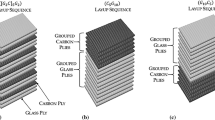The stacking sequence effect of narrow L-shaped laminates on the fracture mode was studied. Two laminate stacking sequences were designed to analyze different fracture modes. The sequence layup J, i.e., [0/904/02/902/02/902/02/90]s trends to highlight the matrix fracture mode, whereas the stacking sequence layup I, i.e., [04/90/03/90/02/902/02/90]s tends to highlight the delamination mode. Load–deflection curves and fracture modes for these stacking sequences under a four-point bending loads were recorded and compared with the plane-strain empirical formula and experimental results. The results show that the stacking sequence has a significant effect on the initial fracture mode of narrow L-shaped laminar composites. Layup J shows matrix-dominant initial fracture due to the weak resistance of inner 90° plies to tangential tensile stresses, whereas layup I experiences delamination-dominant initial failure. The edge effect has a great influence on the fracture mode of layup J-like specimens, whereas it is very weak for layup I-like ones. The stacking sequence also influences the carrying capacity; a maximum fracture load of layup J is apparently lower than that of layup I, by about 23%.





Similar content being viewed by others
References
B. Gozluklu, I. Uyar, and D. Coker, “Intersonic delamination in curved thick composite laminates under quasi-static loading,” Mech. Mater., 80, 163–182 (2015).
R. H. Martin and W. C. Jackson, Damage Prediction in Cross-Plied Curved Composite Laminates, Technical Report NASA-TM-104089 (1991).
C. Thurnherr, R. M. J. Groh, P. Ermanni, and P. M. Weaver, “Investigation of failure initiation in curved composite laminates using a higher-order beam model,” Compos. Struct., 168, 143–152 (2017).
M. H. Hassan, A. R. Othman, and S. Kamaruddin, “A review on the manufacturing defects of complex-shaped laminate in aircraft composite structures,” Int. J. Adv. Manuf. Tech., 91, 4081–4094 (2017).
M. H. Hassan and A. R. Othman, “Contribution of processing parameters on void content in the vacuum bagging configurations of L-shaped composite laminates,” Int. J. Adv. Manuf. Tech., 93, 1333–1345 (2017).
F. Georgiades, “Nonlinear equations of motion of L-shaped beam structures,” Eur. J. Mech. - A/Solid., 65, 91–122 (2017).
M. Fiorina, A. Seman, B. Castanie, et al., “Spring-in prediction for carbon/epoxy aerospace composite structure,” Compos. Struct., 168, 739–745 (2017).
C. Bellini, L. Sorrentino, W. Polini, and A. Corrado, “Spring-in analysis of CFRP thin laminates: numerical and experimental results,” Compos. Struct., 173, 17–24 (2017).
Y. Shi and C. Soutis, “Modelling transverse matrix cracking and splitting of cross-ply composite laminates under four point bending,” Theor. Appl. Fract. Mec., 83, 73–81 (2016).
S. Jimenez and R. Duddu, “On the parametric sensitivity of cohesive zone models for high-cycle fatigue delamination of composites,” Int. J. Solids Struct., 82, 111–124 (2016).
C. T. Sun and S. R. Kelly, “Failure in composite angle structures Part I: Initial failure,” J. Reinf. Plast. Comp., 7, 220–232 (1988).
S. Feih and H. R. Shercliff, “Composite failure prediction of single-L joint structures under bending,” Compos. Part A - Appl. S., 36, 381–395 (2005).
M. R. Wisnom, “3-D finite element analysis of curved beams in bending,” J. Compos. Mater., 30, 1178–1190 (1996).
ASTM D6415/D6415M. Standard Test Method for Measuring the Curved Beam Strength of a Fiber-Reinforced Polymer-Matrix Composite, ASTM International, West Conshohocken, PA (2006).
G. Wimmer, W. Kitzmüller, G. Pinter, et al., “Computational and experimental investigation of delamination in L-shaped laminated composite components,” Eng. Fract. Mech., 76, 2810–2820 (2009).
S. Lekhnitskii, Theory of Elasticity of an Anisotropic Elastic Body, Mir, Moscow (1981).
C. T. Sun and S. R. Kelly, “Failure in composite angle structures Part II: Onset of delamination,” J. Reinf. Plast. Comp., 7, 233–244 (1988).
Author information
Authors and Affiliations
Corresponding author
Additional information
Translated from Problemy Prochnosti, No. 1, pp. 223 – 230, January – February, 2018.
Rights and permissions
About this article
Cite this article
Pan, Z.Y., Duan, Q.F., Zhong, Y.C. et al. Stacking Sequence Effect on the Fracture Behavior of Narrow L-Shaped Cross-Ply Laminates: Experimental Study. Strength Mater 50, 203–210 (2018). https://doi.org/10.1007/s11223-018-9960-2
Received:
Published:
Issue Date:
DOI: https://doi.org/10.1007/s11223-018-9960-2




